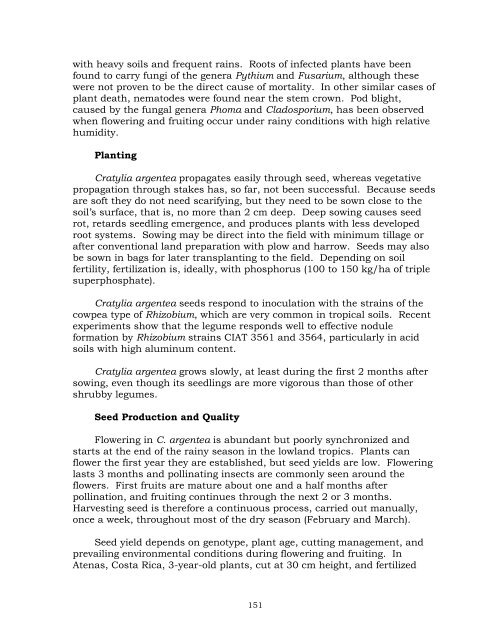Feeding Systems with Legumes to Intensify Dairy Farms - cgiar
Feeding Systems with Legumes to Intensify Dairy Farms - cgiar
Feeding Systems with Legumes to Intensify Dairy Farms - cgiar
You also want an ePaper? Increase the reach of your titles
YUMPU automatically turns print PDFs into web optimized ePapers that Google loves.
<strong>with</strong> heavy soils and frequent rains. Roots of infected plants have been<br />
found <strong>to</strong> carry fungi of the genera Pythium and Fusarium, although these<br />
were not proven <strong>to</strong> be the direct cause of mortality. In other similar cases of<br />
plant death, nema<strong>to</strong>des were found near the stem crown. Pod blight,<br />
caused by the fungal genera Phoma and Cladosporium, has been observed<br />
when flowering and fruiting occur under rainy conditions <strong>with</strong> high relative<br />
humidity.<br />
Planting<br />
Cratylia argentea propagates easily through seed, whereas vegetative<br />
propagation through stakes has, so far, not been successful. Because seeds<br />
are soft they do not need scarifying, but they need <strong>to</strong> be sown close <strong>to</strong> the<br />
soil’s surface, that is, no more than 2 cm deep. Deep sowing causes seed<br />
rot, retards seedling emergence, and produces plants <strong>with</strong> less developed<br />
root systems. Sowing may be direct in<strong>to</strong> the field <strong>with</strong> minimum tillage or<br />
after conventional land preparation <strong>with</strong> plow and harrow. Seeds may also<br />
be sown in bags for later transplanting <strong>to</strong> the field. Depending on soil<br />
fertility, fertilization is, ideally, <strong>with</strong> phosphorus (100 <strong>to</strong> 150 kg/ha of triple<br />
superphosphate).<br />
Cratylia argentea seeds respond <strong>to</strong> inoculation <strong>with</strong> the strains of the<br />
cowpea type of Rhizobium, which are very common in tropical soils. Recent<br />
experiments show that the legume responds well <strong>to</strong> effective nodule<br />
formation by Rhizobium strains CIAT 3561 and 3564, particularly in acid<br />
soils <strong>with</strong> high aluminum content.<br />
Cratylia argentea grows slowly, at least during the first 2 months after<br />
sowing, even though its seedlings are more vigorous than those of other<br />
shrubby legumes.<br />
Seed Production and Quality<br />
Flowering in C. argentea is abundant but poorly synchronized and<br />
starts at the end of the rainy season in the lowland tropics. Plants can<br />
flower the first year they are established, but seed yields are low. Flowering<br />
lasts 3 months and pollinating insects are commonly seen around the<br />
flowers. First fruits are mature about one and a half months after<br />
pollination, and fruiting continues through the next 2 or 3 months.<br />
Harvesting seed is therefore a continuous process, carried out manually,<br />
once a week, throughout most of the dry season (February and March).<br />
Seed yield depends on genotype, plant age, cutting management, and<br />
prevailing environmental conditions during flowering and fruiting. In<br />
Atenas, Costa Rica, 3-year-old plants, cut at 30 cm height, and fertilized<br />
151
















